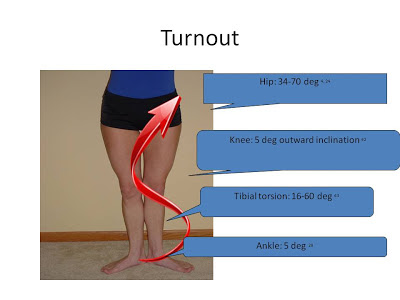Dancers very commonly ask me “what stretches should I do to improve my turnout?” I then ask the dancer what move he/she is trying to improve turnout on. This allows me to decided whether to look for a range of motion deficit, a strength deficit, or a neuromuscular control deficit.
More than 50% of the time, I find that the deficit is NOT a range of motion problem, but rather a strength or neuromuscular control challenge.
This article explains where turnout comes from in the dancer. It will allow us to have further articles and discussions on how to “work turnout” safely and appropriately.
This is a slide from a presentation I gave at the Minnesota Sports Medicine Conference in 2010. Research in anatomy shows that turnout in dancers is created by the following:
1. Hip joint: 34-70 degrees. This means that the hip alone will not allow a foot to face the side of the room.
2. Tibial torsion: 16-60 degrees. Some dancers can get their feet to point to the sides of the room if they have a high degree of tibial torsion. Tibial torsion is how much spiral is in the shin bone. This cannot be changed with exercises.
3. The last 10 degrees comes form the ankle and knee structure.
These key findings indicate that:
1. Not every dancer can have 180 degrees of turnout
2. Dancers may be able to focus on hip exercises to improve turnout
Some of our follow up articles will discuss what types of hip exercises might be appropriate, and what types may be less appropriate.



